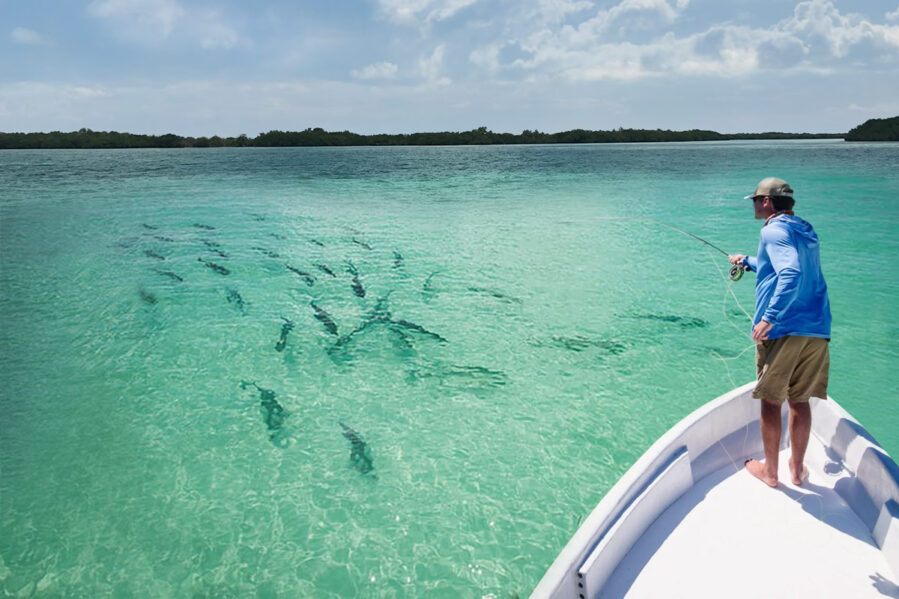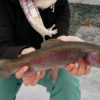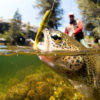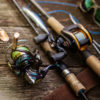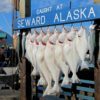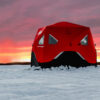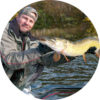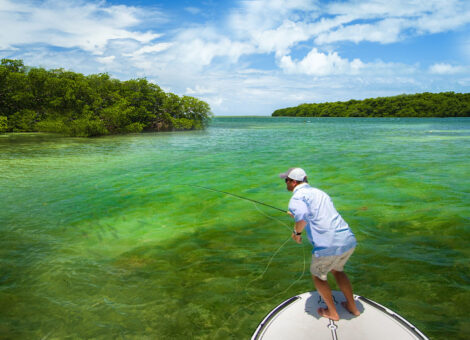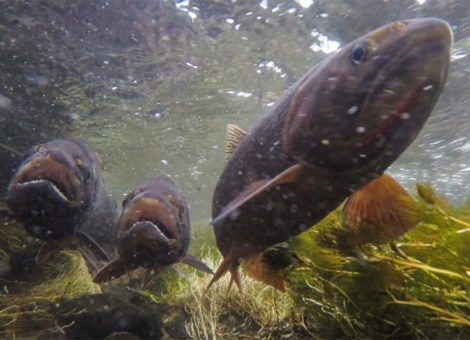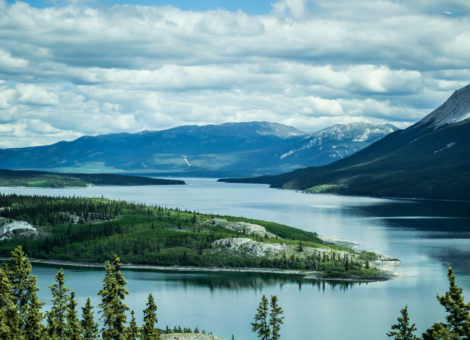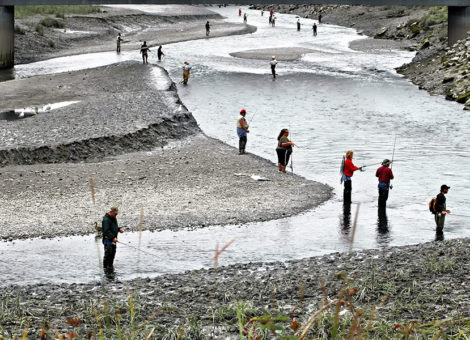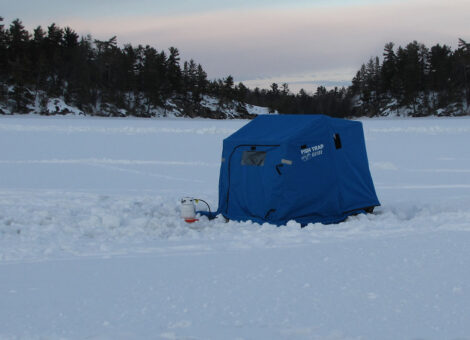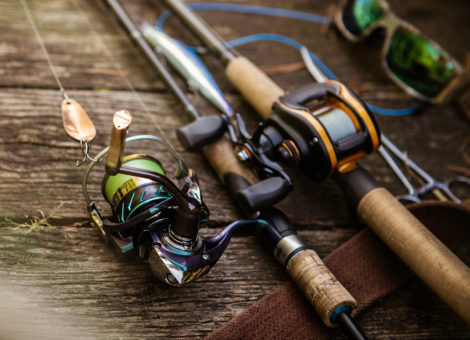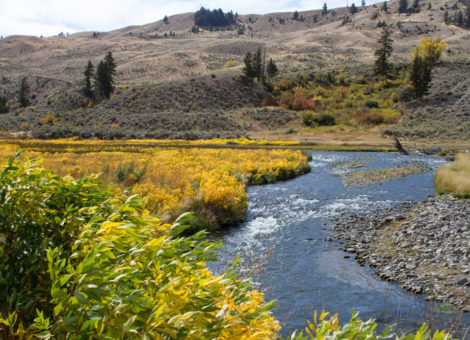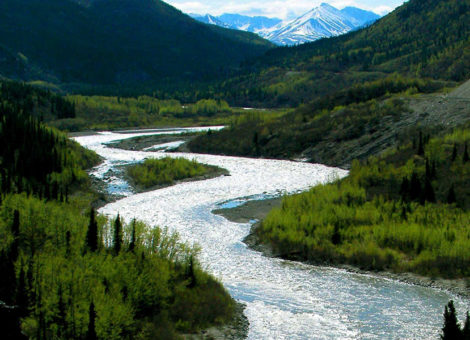I’m no guide, but over the years I’ve done my fair share of flats fishing off Key West and the greater coral cay archipelago, at least enough to be able provide a few insights and offer a solid opinion. So let’s get the opinion out of the way first, then I’ll share a few personal perspectives… and maybe a pointer or two to improve your flats fishing adventure in Key West.
So, my opinion…
I admit reef fishing for giant grouper, or reeling in a behemoth marlin from 200 feet of water are quite the adventures—been there, done that. But neither quite compare to getting down with a 120-pound ‘poon that refuses to admit defeat or stalking a pack of giant tarpon from the black of their backs on the crystal-clear flats of Key West. In my book, only the flats provides the ultimate fish hunting experience.
- When To Go Flats Fishing
- Where To Go Flats Fishing
- How To Flat Fish
- Key West Flats Fish Species
- Getting On The Water
When To Go Flats Fishing
Go whenever you want! That’s one of the beauties of Key West. There’s never really a “bad” time to go fishing. Having said that, there are certainly times of the year that are more conducive than others to a good flats fishing experience. I consider spring, summer and fall the best flats fishing seasons. Warmer temps, longer days, and tropical weather tend to keep the flat full of nice size tarpon, permit and bonefish.
Probably the worst time to go flats fishing is when there’s wind. No one can predict the wind, but my experience is that you’re going to encounter more Easterly winds coming down over the flats during the winter and early spring months. This doesn’t mean you shouldn’t hit the flats in the winter or spring, only that you’re likely to encounter some windy days.
The biggest problem with wind is that it pushes your boat around and kicks up some nice size waves that can make sight fishing a little less “sightly” shall we say (pun intended). When it’s windy out, you really have two choices—and heading to shore isn’t one of them. First, fish through the wind, which is doable. Or even better, head for the backcountry.
I prefer fishing the open flats over backcountry fishing, but that’s only when it’s not windy. On windy days, I’ll often do a combination of flats and backcountry fishing, and it typically works out pretty swell. During early morning and evening I’ll hit the flats. When the wind picks up mid day I head to the back country.
Key West backcountry is littered with little keys and islands, which makes it difficult for the wind to gain much momentum or whip up any nasty size waves that might make fishing unpleasant. I think March is the one month that many Key West charters focus on the backcountry over flats fishing precisely to avoid the wind. But a on warm March day—minus the wind—flats fishing in Key West is as about as good as it gets.
Where To Go Flats Fishing at Key West
Nearly all of the good flat fishing is on the Gulf side of Key West. You’ll find some exceptional flat fishing spots out off Barracouta Keys near Key West National Wildlife Refuge, surrounding Erik’s Bay on Marquesas Keys, and further west at a few isolated spots on Dry Tortugas, but the majority of “Key West” flats fishing occurs just north of Fleming Key east through Big Pine Key, and through the flats along Hwy 1.
If you’re up for a full day of fishing, you can head up the Overseas Hwy (Hwy 1) as far east as Islamorada. There is good flats fishing all throughout this area, but if you want to spend your time fishing, rather than traveling, just north of Key West through Big Pine Key is probably as far as you’ll want to venture.
Below I’ve added a list of good spots for flats fishing near Key West, but first a disclaimer. While some fishing spots are better than others, don’t get hung up on “spots”. Focus on finding good habitat, then fish around a bit. Key West is chock full of fish, and good fishing spots—some of which have yet to be touched by anglers.
Flats Fishing Habitat
Again, focus on habitats first, spots second. If you find the right habitat, I guarantee you’ll find some good fishing spots.
One of my favorite spots to fish the flats are transition zones, especially along the edges of marshes and mangroves. During low tide, permit, bonefish and snappers will often scour the borders of marshes looking for prey. This is a great place and time to cast your line.
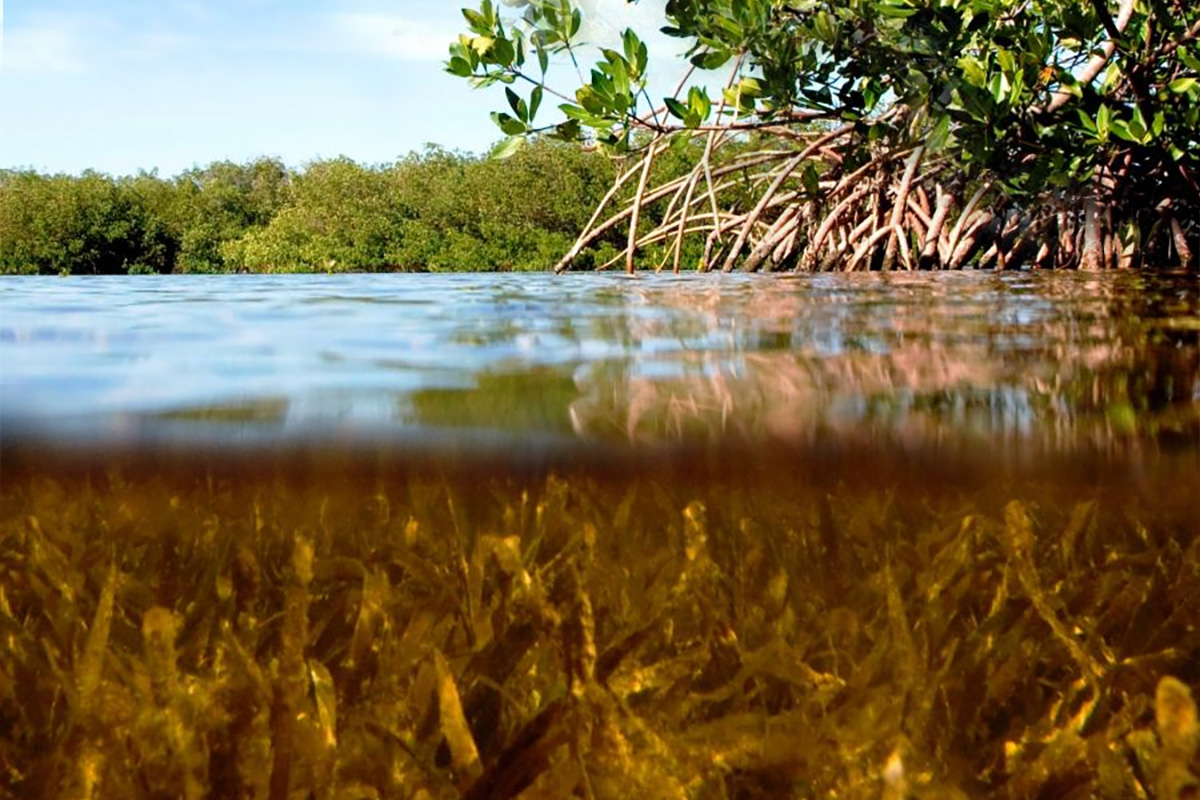
Grass beds are another hallmark of good flats fishing habitat. Grass beds hold a lot of baitfish and crustaceans, and where you find forage, you’ll find predatory gamefish such as tarpon, barracuda, redfish and more. Fly fishing works on grass beds as does spinning. It’s easy to snag a lure on the bottom when fishing grass bed using spinner gear. If you’re not casting flies, fishing a top water lure or a suspending jig works well. As with mangroves, gamefish will patrol the edges of grass beds looking for forage.
As you fish grass beds you’ll come across areas that are void of grass. These are called potholes. They vary in size and shape, and are great areas to target. Small baitfish and crustaceans will often move across potholes to “greener pastures” only to get gobbled up by redfish or sea trout that lying in wait. Fishing your lure along pothole edges will get you some good hookups.
Certain types of fish, such as grouper, grunts or croakers, typically hold to the deeper water on the flats. Channels, cuts, and deeper holes located throughout the flats are ideal spots to target fish. Bouncing a bait along the bottom of a channel or fishing a Carolina rig is a productive technique.
Channel entrances are another prime location for finding fish. Anywhere water is being forced through a small area, the bottom is going to be deeper and baitfish are going to concentrate. And again, where there’s bait fish, you’ll find larger predatory gamefish looking for their next meal.
Okay. So below are few of my favorite spots near Key West that I recommend for flatsfish. Click on any of the links to be taken to the location on Google Maps.
- Mooney Harbor (Marquesas Keys)
- Lakes Passage (Key West National Wildlife Refuge)
- Jack Channel
- Garisson Bight Channel
- Calda Channel
- Bluefish Channel
- West Harbor Key Channel
- East Harbor Key Channel
- Lower Harbor Keys (North End)
- East Harbor Keys
- Jewfish Channel
- Jewfish Basin
- Mud Keys (East Side)
- Mud Key Channel
- Outer Narrows
- Barracuda Keys Channel
- Lower Sugarloaf Key
- Sugarloaf Creek Inlet
The areas surrounding the locations listed above should provide good flats fishing. As you move east toward Big Pine Key, you’ll find a lot more good flats fishing territory. Again, pay attention to the water and the habitat and you’ll find great fishing.
Spend some time on Google Maps identifying some good habitat and mapping out a route before hitting the water. This will give you some direction and a good head start. Alternatively, hire a local guide that can take you out and show you the ropes.
How To Flats Fish
What I love most about flat fishing is the hunt. There’s nothing quite like stalking a school of tarpon from the black of their backs by sight. Flats fishing requires stealth, accuracy and patience—all trademarks of a true hunter and flats fisherman. You don’t need to be a seasoned angler to enjoy the flats, but coming with a strategy and a little know-how will go a long way.
Sight fishing is the name of the game on the flats. Regardless of your preferred fishing method, the key to fishing the flats if finding the fish. I wouldn’t ever recommend flat fishing, or any other type of off shore fishing, going solo. At minimum, flat fishing is a two person endeavor. One person guides the boat, or skiff, while the other spots the fish and does the casting.
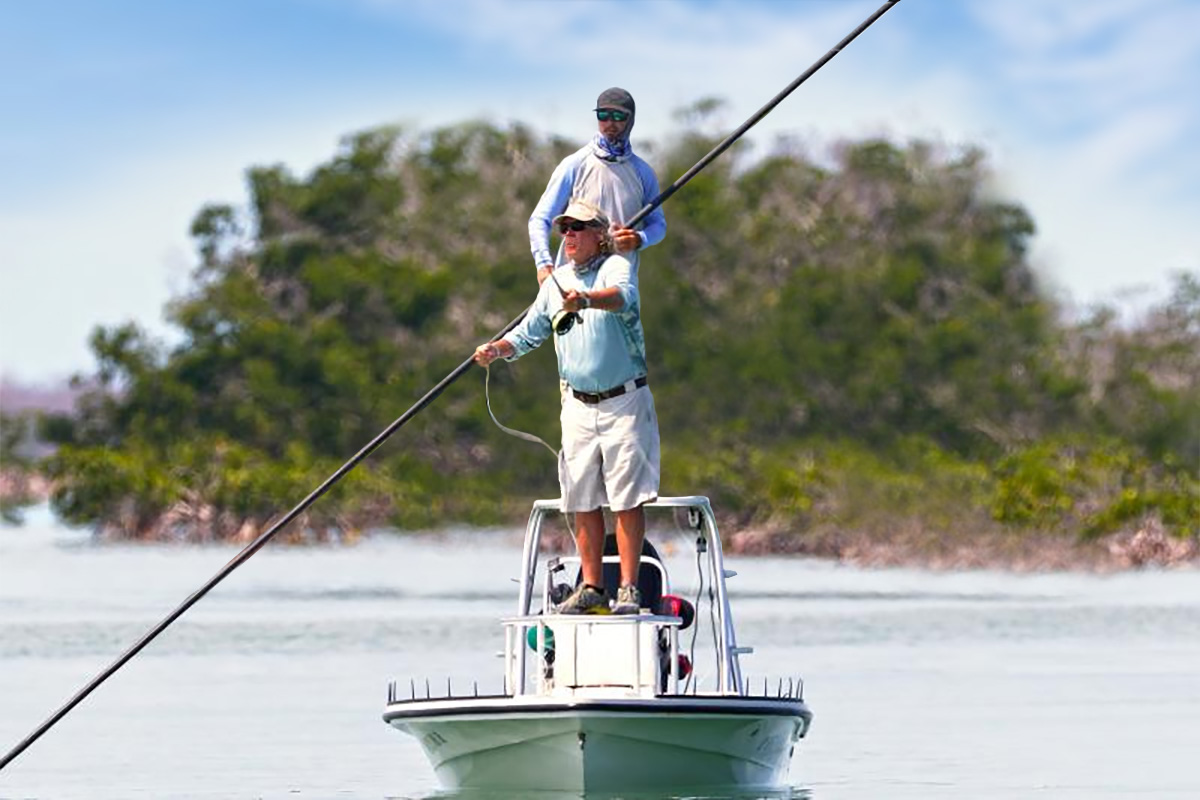
The two primary methods for fishing the flats are with spinning gear or fly fishing. Which method you use is really a matter of personal preference. What’s most important is that you’re comfortable with your casting technique and can get your bait, or fly, where it needs to be at a moments notice. Good casting technique is the second key to flats fishing.
And don’t forget a good pair of polarized sunglasses. These are essential for spotting fish just below the surface.
Key West Flats Fish Species
There are over 40 species of game fish in the waters off Key West, and a good number of those fish are found on the flats at certain times of the year. From barracuda to bull shark, there’s a good chance if you spend enough time fishing the flats you’ll come across most species. However, without question, the three most popular targets on the flats are tarpon, bonefish and permit. On a good day, you’ll see all three. On a great day you’ll catch all three.
The Mighty Tarpon
Considered the ultimate prize by most flats fisherman, the tarpon is the biggest draw to the Key West flats. Tarpon, locally referred to as ‘poons or Silver King, are 80-300 pound prehistoric behemoths of a fish that can reach 8 feet long. If you’ve never hooked a tarpon, you haven’t experienced Key West fishing at its finest. I’ve never pulled in a 300 lb tarpon off the flats, but I’ve heard stories. Your average tarpon is going to be in the 40 to 70 pound range, but a lunker over 150 pounds is out there waiting for you.
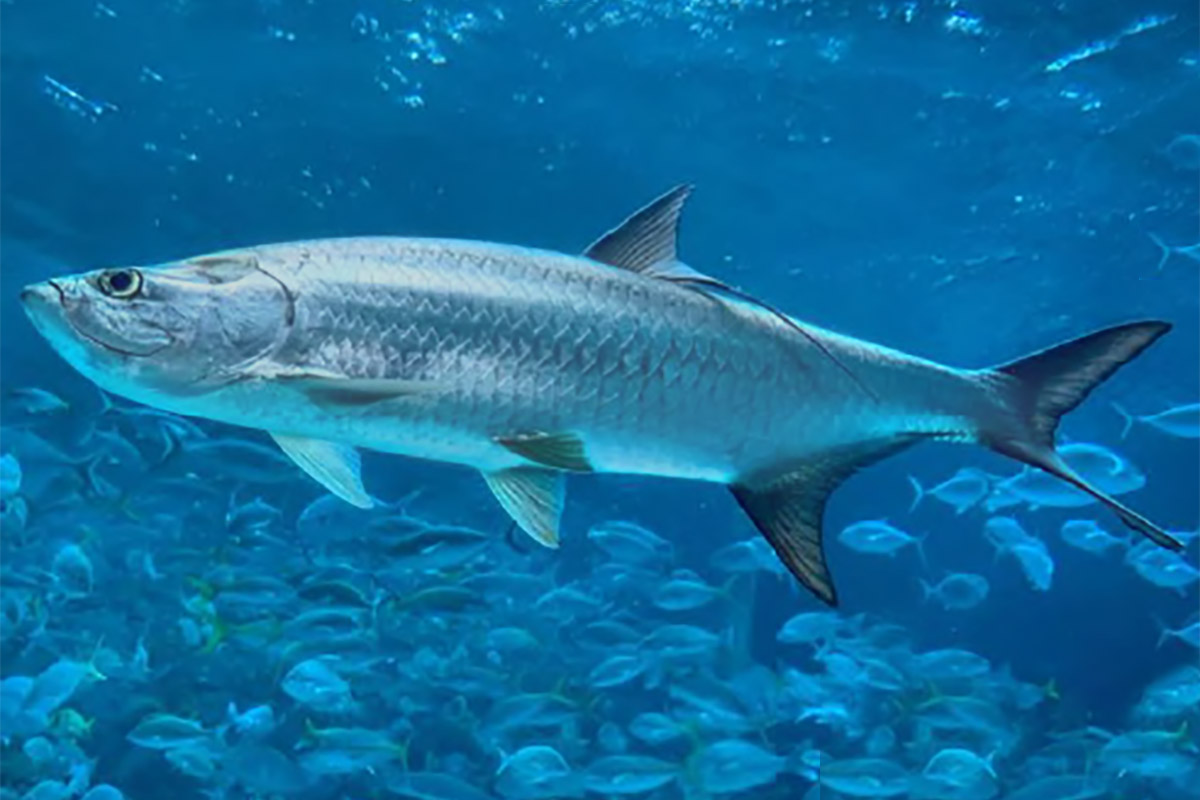
You can fish tarpon on the flats, or really any shallow water, using a spinning setup or with fly fishing gear. A lot of anglers prefer throwing bait. I prefer stalking tarpon with a fly, it’s just a little more exhilerating to me, but a good spinning rod reel combo, with the right cast, will pull them in just as well.
Remember, tarpon are big fish, with big attitudes, so come prepared to take the fight to them—because they’re certainly gonna bring the fight to you. If you prefer spinning gear, I recommend an 7′ to 8′ extra heavy action rod with a 5500 to 6500 reel, a 30 pound test braided line, 50-80lb braided or fluoro leader and a 6/0 in-line circle hook. I might even recommend going up to a 8000 series reel, and a slightly bigger line, if you’re set on reeling in some lunkers.
As mentioned previously, one of the keys of sight fishing on the flats is your cast, and the key to casting for tarpon using spinning gear is to get your bait in front of them. Casting over, on top of, or behind them, will send tarpon running and your ruin your chances, and those of any other angler in the area. Be smart, be courteous, and be responsible.
Figure out which course the tarpon are pursuing then cast your bait well in front of—and beyond—their path. If tarpon are about 40 feet off the bow of your boat at the 11 o’clock position, you want to cast to the 9 o’clock position about 60 to 70 feet out. Upon retreival, your bait should intersect the tarpons’ path a few feet in front of them. As you continue to retreive, and tarpon see your bait, or lure, “swimming” away in a natural fashion, the strike instinct kicks in and you’ll get a bite.
I’m not going to get deep into fly fishing technique here, but the principles for targeting tarpon with a fly are similar to casting with bait using a spinning reel. You want to get your fly in front of them. Tarpon are opportunistic feeders and fly selection isn’t as important as where you place your fly, but you still want a fly that resembles a tarpon’s nature pray.
Tarpons love blue or pass crabs. Any fly, lure or bait resembling a crab is likely to get a strike if it’s fished correctly.
The Elusive Bonefish
The “grey ghost”, more correctly called Bonefish, is one of the more elusive fish in the Keys. They’re fast, stealthy and a challenge to catch. Next to the mighty tarpon, a bonefish looks like a minnow. Your average bonefish is between 3 to 5 pounds. If you hook anything over 10 lbs, consider yourself lucky. Notwithstanding it’s small size, this unassuming specimen of a fish is one of the most sought after gamefish in the world—and a top target in Key West.
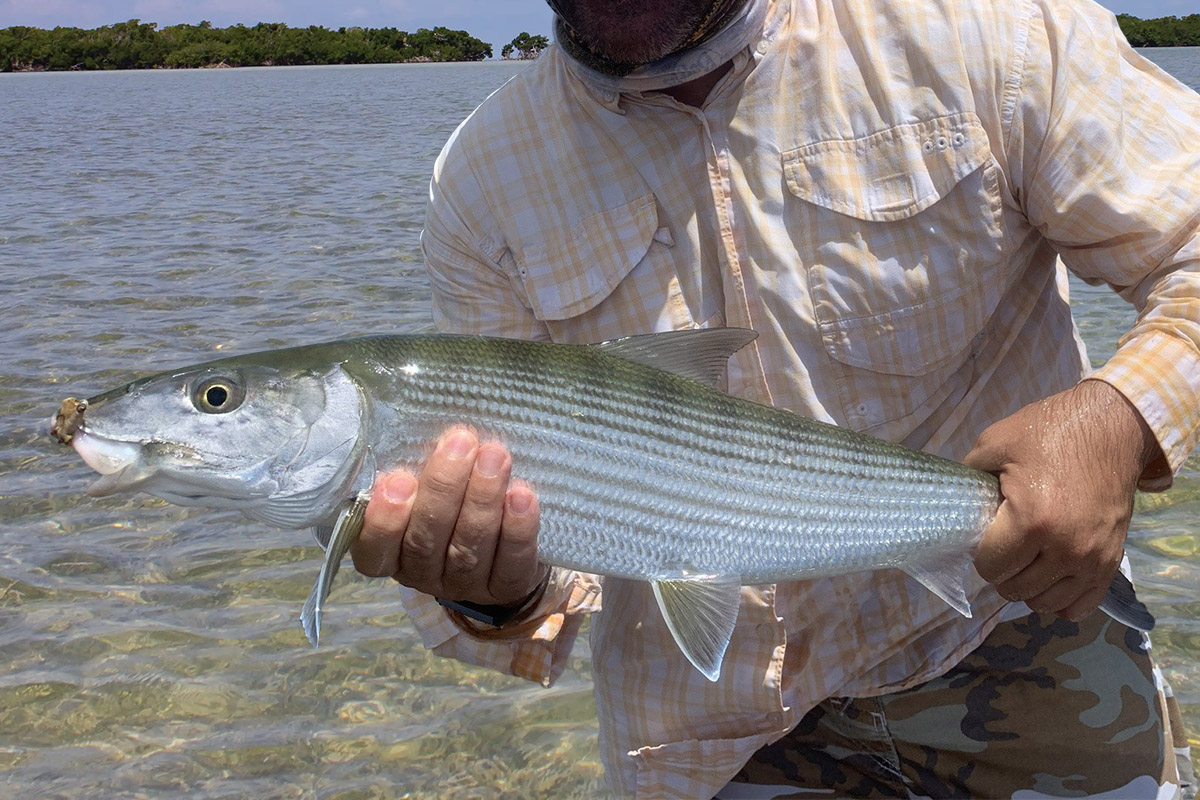
Bonefish start appearing sporadically across the flats in April as water warms. By mid summer they’re crawling all over the flats. Bonefish are traditionally fished by sight in shallow water—such as flats. Patience, stealth and an accurate cast are key to hooking this elusive fish. As with tarpon, bonefish can be targeted using spinning gear or a fly.
Hunting bonefish with a fly is only second in my book to targeting tarpon with a fly, but tomayto, thomahto—they’re both a blast to catch! As with tarpon, your casting technique is key. Don’t cast at them, or behind them. Get out in front of them with a natural presentation and hope they bite. Bonefish are skittish creatures. You land a fly on them and they’re more likely to scatter than take your bait.
If you haven’t fished for bonefish before, something you probably wouldn’t know is that they’re fighters. I’d dare say, pound for pound bonefish are bigger fighters than tarpon. A decent size bone fish will take a 100 yards of line of your reel in the blink of an eye.
You can use lighter gear when targeting bonefish, but you still want a good rod with casting ability. A 7 to 9 foot rod, with 10 to 15 lb test line is really all you need to get started. I usually go with the longer rod when fishing early season to help get my bait through the wind.
And bonefish love shrimp. So bring plenty along.
The Feisty Permit
I wouldn’t say that fishing for permit is any less exhilerating than hunting tarpon or bonefish, but obviously it’s third on my list here. Actually, flats fishing for permit or bonefish is really 6’s for me, and I arrive prepared to fish all three fish species.
There are some big permit on the flats at Key West, and these fish are absolutely beautiful. They remind me of a silvery, oversized angel fish. Permit are anywhere from 10 to 40 lbs, quite large compared to a bonefish (or angel fish). They’re also strong fighters. They will battle you until their last breath. Some anglers describe permit as “crevalle jack on steroids”.
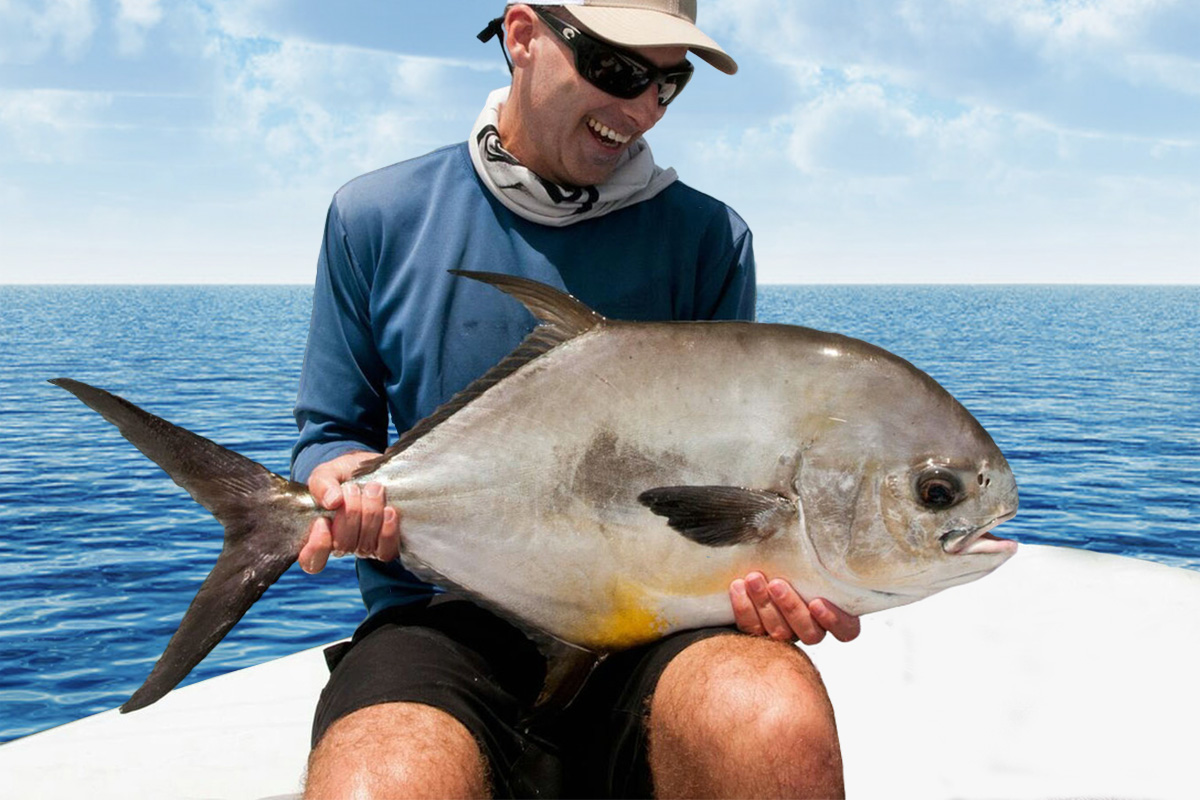
Like bonefish, permit are skittish. If they sense you, before you see them and are able to get a cast, game over. They’ll split and run (swim) for deeper water at the slightest indication of danger, or your presence. Fishing permit in 2 to 3 feet of crystal-clear water is a challenge.
Permit are found on the flat year round, but they’re a bit scarcer during the month of April when adults move offshore to spawn. The pre-spawn months of February and March, and the later summer months moving into fall, are prime time sight fishing season for permit. During late summer and early fall, it’s not uncommon to come across schools of up to 50 permit in the shallows—and permit are typically quite solitary.
You can fish permit in the spring or summer, but again, you’re going to deal with a lot more wind in the spring. If you want to ensure some glassy water, and a calmer ambient, fall fishing on the flats is where it’s at.
As with tarpon and bonefish, permit can be taken with spinning gear or a fly. They’ll readily take lures, jigs, bait (especially live crab) and flies. They’ll even take a bucktail jig.
Other Flats Species
Ninety percent of anglers on the flats come for the tarpon, bonefish and permit action, but they are a lot more fish species on the flats than most anglers realize. Other gamefish you may encounter on Key West flats include:
- Redfish. Aka ‘Red Drum’. Are found throughout the flats and make a tasty table fare.
- Snook. Rare, but every once in a while you’ll come across a school of large Snook.
- Lemon Shark. Most common shark on the flats.
- Bull Shark. At 10+ feet and 300-500 lbs one of the biggest sharks you’ll find on the flats.
- Nursh Shark. Up to 14ft and 300 lbs. Sometimes found foraging in the deeper channels on flats.
- Blacktip and Spinner Sharks. Both species are somewhat rare on the open flats. You’ll come across some blacktips and the occassional spinner shark.
- Hammerhead Shark. Not common on the flats, but when you see one you’ll never forget it.
- Bonnethead Shark. Small 3′ shark found throuhout the flats. Fun to fish.
- Atlantic Sharpnose Shark. Small 4′ shark with razor sharp teeth. They put up a fight when hooked.
- Mutton Snapper. Typically found closer to backcountry areas with a little structure. Up to 10+ lbs.
- Mangrove Snapper. Great table fare. 1-4 lbs average in the flats and backcountry.
- Yellowstail Snapper. Not as common on the open flats. 1-4 lb average size.
- Lane Snapper. A smaller cousin to the mutton snapper are found along the edges of flats and backcountry.
- Goliath Grouper. You’ll find juveniles in mangrove estuaries and larger specimens in shallow waters with structure and ledges.
- Red Grouper. They’ll take baits and lures. Typically limited to the larger channels running through the flats. Keepers must be over 20″.
- Gag Grouper. Found in the deeper mangrove island channels. Keepers must be over 24″.
- Jack Crevalle. Aggressive feeders that will take just about any bait. Average size of 2-8 lbs. Abundant in the flats.
- Yellowjack. Take live bait as well as a variety of lure. Specimens up to 20lbs found in the backcountry flats.
- Pompano. You’ll find some schools in backcountry basins during the winter and spring months.
- Blue Runner. Will take small jigs and flies. They often patrol the edges of backcountry and flats.
- Horse Eye Jack. Average 3 to 5 pounds. Similar to the jack crevalle, but smaller.
- Barracuda. Reach up to 20 lbs and are found throughout the flats and backcountry. Most abundant during the winter months.
- Spotted Sea Trout. Found throughout the flats during the cooler winter months.
- Cobia. Get up to 40 pounds in the backcountry. Fun to catch and provide an excellent table fare.
- Mackerel. King, Cero and Spanish mackerel move into the flats and backcountry during winter season.
- Ladyfish. Aggressive fish that is fun to catch. Puts on an acrobatic display when hooked.
This about rounds out the selection of what you may encounter in the Key West flats. I haven’t caught every fish listed above, but am working on it. Focus on targeting the three biggies, tarpon, bonefish and permit, and just be ready to take advantage of the opportunity to hook other fish species as they appear. That’s my philosophy.
Getting On The Water
While most anglers fish the flats from a skiff or flats boat, it ain’t the only way to get out where the fish are. There are still a few old schoolers that wade out onto the flats from shore, or even jump in the water once they find the perfect spot. Heck, why not? The water is only 2 or 3 feet deep, and in some places it’s crystal clear. Anglers can tackle the flats wading, from a flats boat, a shallow-draft boat with a motor, or kayak. You’ll even see a few anglers these days out fishing from paddle boards.
Wade Fishing
Wade fishing the flats isn’t for me, but it’s still a viable option that a few diehard anglers really enjoy. I think the biggest downside to wading is that you’re flying (“fishing”) blind. For me the entire point of flats fishing is the hunt, and it’s hard to hunt something you can’t see. You can definitely catch fish wading, but be prepared to make a lot of casts and cover a lot of water.
On Key West there are only a few spots I can think of where you can realistically access the flats from shore in waders or wade casting, but you’ll see anglers doing it throughout the lower keys—mostly on Lower Matacumbre Key, Islamorada, Long Key, Marathon Key and Bahia Honda Key. Occassionally, anglers will venture out on a skiff or shallow-draft boat, anchor, jump in the water, and then wade fish. Seems a little counter intuitive, but there’s some reason behind the madness.
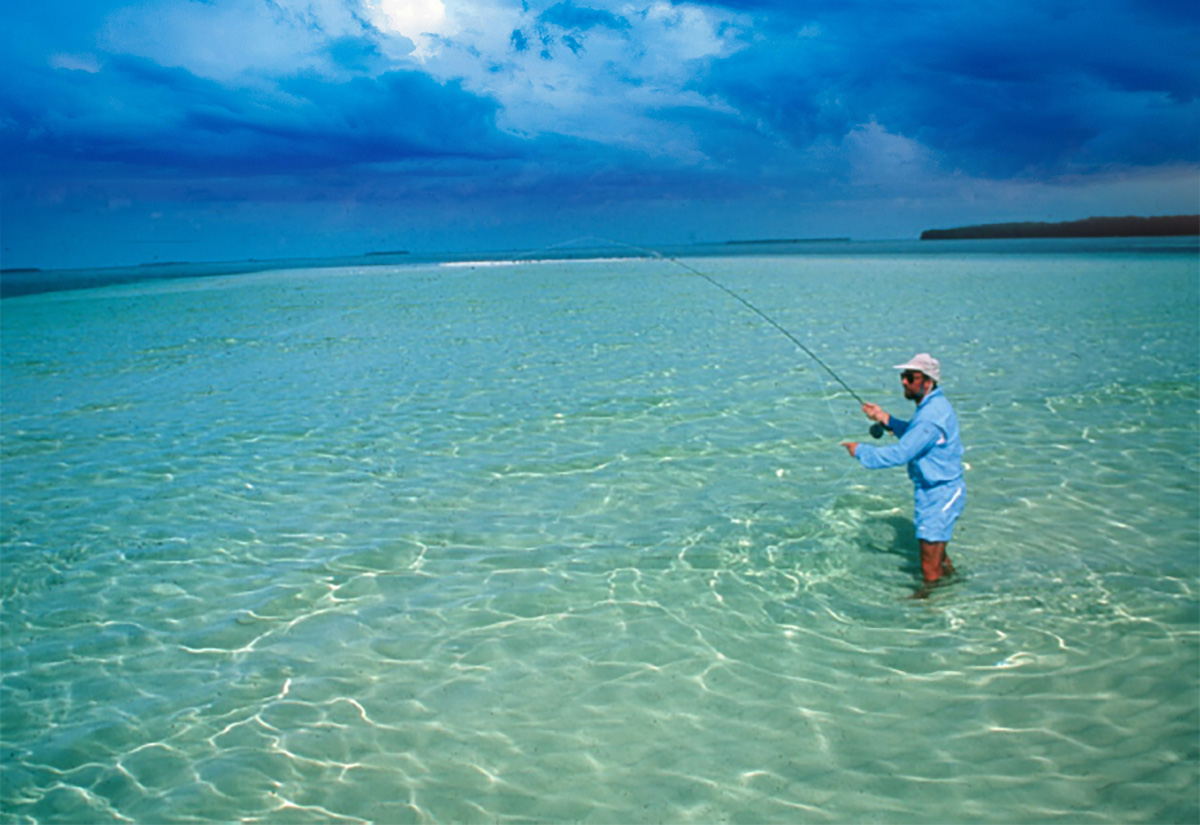
One of the more strategic benefits of wade fishing the flats is stealth. A bonefish can sense a boat coming a mile a way, especially if it’s got a small motor running. But a wader, motionless in 30 inches of water, is almost invisible until the fish is within about 10 feet. A fly fisherman casting a thick fly line a foot or two above the surface from the bow of a skiff is more conspicuous than a wader down in the water.
Wading for “tailing bones” is one of the few strategies that sounds fun, but I’ve yet to experience. It it accomplished by wade fishing just off shore in skinny water as bonefish feed on crabs along the bottom. When you hear the click, click sound near you, you’ll know there are bonefish nearby munching on crabs. You’ll also see translucent forked tails protruding just above the surface, which means that bonefish are head down feeding. Cast your fly, or bait, in the area you see the tails, hear the munching, or see puffs of mud coming off the bottom. I’ve heard tailing bonefish can be a lot of fun, and I’ll bet it is.
Oh… and if you’re going to wade fish, a word of advice. Don’t spit in the wind. Don’t step on stingrays. And, watch for sharks.
Flats or Pole Boat
Now that I’ve spent a bunch of time talking about wade fishing—my least favorite form of flats fishing—I’ll spend a little bit of time talking about my favorite way to fish the flats—from a flats or pole boat.
Pole-boats are shallow-draft boats that are ideal for flats fishing. The setup with a flats boat is simple. One angler stands on the stern of the boat, sometimes from a raised platform, pushing the boat slowly across the flats, while a second angler casts from the bow. The raised platform allows the angler to spot fish a great distance away. Using a pole is much quieter, and stealthier, than using oars or a trolling motor for propulsion.
Pole-boats ride low in the water, are flat-bottomed, and are extremely stable for standing and casting. However, when you stand you become more visible and can spook wary fish. When fishing from a pole-boat I recommend keeping as low a profile as possible and holding your rod high in the air.
I think the only noteworthy drawback to pole-boats, when compared to a traditional shallow-draft boat, is stability. It’s a rare occurance, but small pole-boats have been known to get swamped when the water gets rough.
Shallow-draft Boat with Electric Motor
Comfort and convenience. The two biggest benefits to flats fishing with a shallow-draft motorized boat. Obviously, motorized boats are a little noisier and less stealthy than a pole-boat, but you’ll still get close enough to make some good catches.
Most charter companies that haul anglers around on the flats use shallow-draft motorized boats. The biggest advantage of using one of these boats is, when conditions turn south, they’re big enough to handle it—or quickly get you back to “terra firma”. During winter and early spring, when it can get windy, a boat with a motor is very desirable.
Motor boats are also easy to maneuver and much more comfortable for extended periods of time fishing on the flats.
Kayaking
Flats fishing is all about the hunt. It’s about connecting with nature and getting right down in the action. And there’s no better way to do that than from a kayak.
In my book, kayaks are the ultimate flats fishing watercraft and provide the ultimate flats fishing experience for the avid angler. They’re fast, they’re sleek, they’re safe, and most importantly, they’re fun!
There are so many different types of fishing kayaks on the market today, with so many amenities and features, there’s really something for anyone, and everyone, that’s interested in kayak fishing. There are paddle kayaks, pedal kayaks and motorized kayaks.
Kayaks are extremely stealthy. You sit low enough in the water that most fish don’t see you, and when they do, they just see some large shape floating on the water.
The biggest drawback of kayak fishing is space. There isn’t a lot of room on kayak for unnecessary gear, or storage space for hauling around a big fish if you choose to harvest it.
But with so many options on the market today, you’re sure to find a good fit. A few personal recommendations when purchasing a kayak. First, don’t scrimp. Spend a little money and get a kayak that’s comfortable and meets all your needs. Second, make sure it has enough space for your fishing gear. No point in getting a kayak for fishing, if it can’t handle your gear. Finally, invest in a trolling motor.
You can reach plenty of good fishing spots with just a paddle, but having an electric trolling motor, even a small one, will make your experience that more enjoyable. Instead of expending energy and time paddling around, you can focus on fishing and let the motor provide needed propulsion.
Oh yeah. And I also recommend a pair of outrigger stabilizers if you’re going to be fishing in any windy or challenging conditions. Stabilizers will keep you upright at all times, and ensure a safe trip. (It’s also nice not tipping over when you have a 100 pound tarpon on your line.)
Paddle Board
I’m seeing a growing number of people heading out on the flats with a fishing rod atop paddle boards—especially the larger Stand Up Paddleboards (SUPs). These buoyant paddleboards are tantamount to a ginormous surfboard that is so stable you can stand up on them while fishing.
One of the biggest benefits of a paddleboard over a kayak for flats fishing is vantage point. It’s easier to stand up on a paddleboard and spot fish while paddling than it is from most kayaks.
You’d think a paddleboard would be less expensive than a kayak, but it isn’t the case. A good paddleboard for flats fishing will run you into the thousands. And these days, there are almost as many options for fishing paddle boards as there are for kayaks. And if you think you can mount a trolling motor to a paddleboard, think again. Take a look at this sweet Saturn Inflatable SUP with 55lb electric trolling motor setup.


